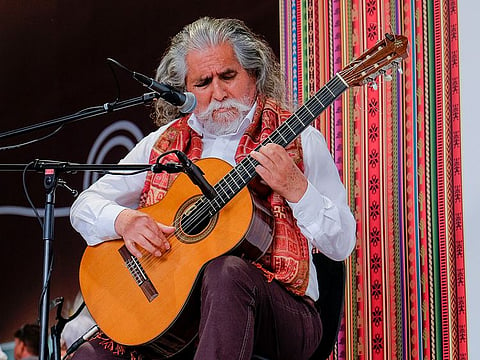Peruvian guitar maestro at Expo 2020: ‘Performing in Dubai feels magical’
With over 50 years of musical mastery, Manuel Prado honours guitar’s Arab origins

Dubai: According to the Incan worldview, the universe is split into three worlds called the ‘pachas’. If Ukhu Pacha is the underworld, then Kay Pacha is the living realm and Hanan the upper cosmos – a trilogy that connects one’s past, present and future. The indigenous belief still lives on in modern-day Andes, after all it helped conceptualise the Peru Pavilion at Expo 2020.
“In World Expos, we always try to show that Peruvians respect and learn from our past, are mindful of the present so that we can think about our legacy in the future,” said Amora Carpajal, commissioner general of the pavilion, in an interview with Gulf News following the opening ceremony.
“When you go through the pavilion, you first walk on the Q'eswachaka Bridge made of straw that is rebuilt every year – a good example of our community values. Then you enter the three worlds, going through the Andes Mountains, the Amazon forest and the coast. In the opening performances, we invited maestros to share their culture and wisdom because we need to respect them.”
Guitar maestro sings Incan tunes
One such maestro hailing from the southern city of Ayacucho thrilled the Expo audience with just an acoustic guitar and a microphone. Seasoned fingers flew across the strings, accompanied by rich baritone vocals that sang of hope and despair but also the beauty of the Andean highlands.
Before he begins, the guitar is introduced as a musical instrument of Arab origins, a venerable object that exchanged hands from Muslims in Andalusia to Peruvians from Spain.
Manuel Prado Alarcón speaks to Gulf News in Spanish, aided by an interpreter, about his indigenous roots, traditions and love for music. Ancient genres of the Incas such as Harawi and Huayno are preserved in his guitar chords, as they have been for generations in Alarcón family. Halfway through his performance, he was joined by his daughter, Trilce Prado Díaz, who he says is also one of his many pupils.
“I learned to play from my parents, aunts and neighbours. The entire community is involved. Now I’ve taught my children as well,” he said of the legacy, which will no doubt continue through his grandchildren and academy back in Puquio. Well-versed in guitars since the age of 12, Alarcón has been teaching the instrument for 30 years, composing and performing on the side.
Using music to link two worlds
Each region brings its own distinct strumming to the table; though Peruvian coasts might carry a western influence, the Andes’ cities have always been loyal to their aboriginal heritage. Alarcón says when the Spanish arrived in Peru with the guitar, it was quickly absorbed into the Incan style of music, one that consisted of bone flutes, panpipes and drums.
“One day, I had a jamming session with a friend who brought over an Arabic drum,” he recalls his first encounter with an instrument from the region. “When I arrived in Dubai yesterday, I asked the driver to play some Arabic music – I wanted to know more.
“It was magical,” he said of his opening performance at the Peru Pavilion. “Harawi is a difficult genre to sing in an open space because it’s not meant to be sung loudly. What I wanted to do was draw a connection between the Andes and the Emirates, the old Arab world and ancient Peru.”
Sign up for the Daily Briefing
Get the latest news and updates straight to your inbox



